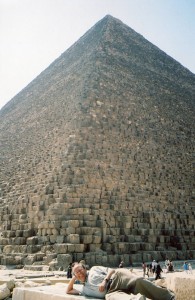by bria4123 on December 3, 2011
by bria4123 on December 3, 2011
The Great Pyramid at Giza was already ancient when Homer’s epics laid many of the ancient West’s foundations. Yet it’s as tall as a modern skyscraper. In its original limestone casing, it soared to 481 feet.
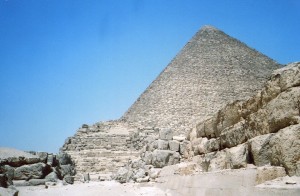
Its builders lived around 2550 BCE. That was more than 2,000 years before China’s Qin Shi Huang’s army of laborers erected his pyramid. What could have inspired such early people to build so big? [click to continue…]
by bria4123 on November 30, 2011
I found Sukhothai one of the most enchanting places in the world. The grace in its ritual center (see More Thai Grace in Sukhothai) rippled throughout the surrounding land and into the hills.
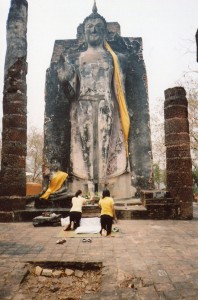
Dozens of shrines and monasteries bejewel the land outside the ancient city wall, and many temples glitter in the hillsides. My favorite hill shrine is Wat Saphan Hin. Let’s spread our wings again and explore it. [click to continue…]
by bria4123 on November 29, 2011
Hang out in Sukhothai long enough, and you might find it more enchanting than Angkor Wat. We can begin to see why by exploring its center, Wat Mahathat.
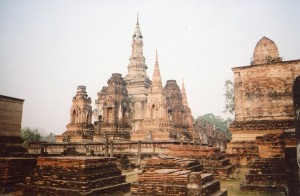
Angkor Wat’s scale is overwhelming. Wat Mahathat glistens with lots of human-scale buildings. Their varied forms are so lithe that a walk through the place can make you feel that you’re floating in the heavens. Let’s spread our wings for a few minutes. [click to continue…]
by bria4123 on November 27, 2011
More roots of Angkor Wat grew in northern Cambodia. Around 500 CE, communities there built a kingdom, or a network of independent cities, called the Chenla. It traded goods and ideas with the Funan (please see Roots of Angkor Wat; Cambodian Origins in the Funan Culture). Many Funan people were now migrating north.
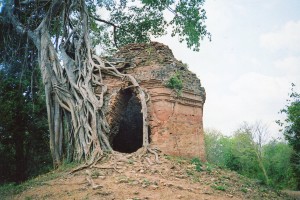
A cultural synthesis followed that the Khmer culture that built Angkor Wat grew from. [click to continue…]
by bria4123 on November 27, 2011
Changes accelerated in Ancient Egypt in the 4th millennium BCE. The Naqada cultures replaced the older Badarian and planted more of Egyptian civilization’s roots.

The Naqada cultures flourished from 4000 to 3050 BCE. Egypt was unified into the culture school books tell you about between 2900 and 3000 BCE. So what the Naqada accomplished was as foundational for Western civilization as you can get. [click to continue…]
by bria4123 on November 26, 2011
Where did Angkor Wat come from? The first big state in Cambodia was the Funan. It thrived in southern Cambodia and Vietnam from about 1 CE to 600 CE. Many of Angkor’s roots grew there.

At least the Chinese saw the Funan as a state, but it might have been a network of smaller communities.
Being by the sea, the Funan prospered from maritime trade. It thrived in the emerging economic system that linked Rome, India and China in an unprecedented increase of prosperity and political organization. While Rome erected the great forums and the Coliseum, the Funan dug a network of canals to link its major towns.
In the first century CE, commerce between India and Southeast Asia increased, and Cambodians were exposed to increasing influences from India. A creative explosion soon occurred. [click to continue…]
by bria4123 on November 26, 2011
No ancient civilization fascinates people more than Ancient Egypt. But how did it emerge? Recent studies show that Ancient Egypt’s origins are more interesting than most people have thought.

Ancient writings made it seem that Egypt emerged as dramatically as the Nile’s flooding. A great king (sometimes called Menes, sometimes called Narmer) conquered the north, founded the city of Memphis, and unified both areas of the Nile by 2920 BCE. But the facts behind the myth are more interesting. [click to continue…]
by bria4123 on November 25, 2011
by bria4123 on November 23, 2011
Ancient Indians believed that clouds are elephants’ celestial relatives. They actually called an elephant “Cloud” (Megha) when they honored it.
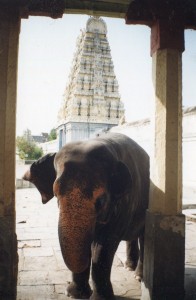
According to the great Heinrich Zimmer, the elephant is a raincloud walking on earth. It’s presence attracts its winged fellow clouds. Honor it, and it’s relatives are gratified and bless the land with rain.
Africans more commonly thought that humanized deities and ancestors bring rains. But ancient Indians had their own thought patterns. [click to continue…]

